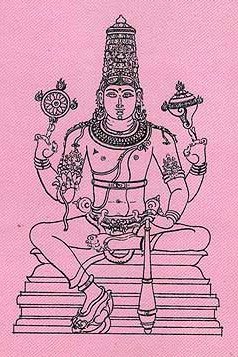Sarvabharana, Sarvābharaṇa, Sarva-abharana: 6 definitions
Introduction:
Sarvabharana means something in Hinduism, Sanskrit. If you want to know the exact meaning, history, etymology or English translation of this term then check out the descriptions on this page. Add your comment or reference to a book if you want to contribute to this summary article.
In Hinduism
Shaktism (Shakta philosophy)
Source: Google Books: ManthanabhairavatantramSarvābharaṇa (सर्वाभरण) refers to “all the ornaments”, according to the Manthānabhairavatantra, a vast sprawling work that belongs to a corpus of Tantric texts concerned with the worship of the goddess Kubjikā.—Accordingly, “(Kāmahā) the Maṅgalā from Kāmarūpa has four faces and is very powerful. She has two arms and sits on a ghost. She makes gestures of fearlessness and boon bestowal; she is well adorned with all the ornaments [i.e., sarvābharaṇa-bhūṣitā] and has a large, pleasing and auspicious face”.

Shakta (शाक्त, śākta) or Shaktism (śāktism) represents a tradition of Hinduism where the Goddess (Devi) is revered and worshipped. Shakta literature includes a range of scriptures, including various Agamas and Tantras, although its roots may be traced back to the Vedas.
Shaivism (Shaiva philosophy)
Source: Brill: Śaivism and the Tantric TraditionsSarvābharaṇa (सर्वाभरण) refers to “(being equipped with) all suitable ornaments”, according to the 9th-century Sarvajñānottaratantra chapter 18.—Accordingly, “Next, I shall teach the best observance among observances, which is known as the Śiva-vrata and which is revered by Asuras and Gods alike. Pure pale ash [should be used, and] white dress and unguents; he should wear a white sacred thread and be adorned by a chignon of matted locks. He should be equipped with all [suitable] ornaments (sarvābharaṇa-sampanna), [and] adorned with white garlands; he should consume [only the pure ritual gruel-offering known as] caru; he should observe the chaste conduct of a student; he should venerate Śiva, the fire and his Guru. [...]”.
Source: SOAS University of London: Protective Rites in the Netra TantraSarvābharaṇa (सर्वाभरण) refers to “all jewels”, according to the Netratantra of Kṣemarāja: a Śaiva text from the 9th century in which Śiva (Bhairava) teaches Pārvatī topics such as metaphysics, cosmology, and soteriology.—Accordingly, [verse 11.1-24ab, while describing the appearance and worship of Tumburu]—“[...] [He worships] Deva as Tumburu in the middle of an eight petaled lotus, in the maṇḍala, [starting] in the East, O Devī. [...] He [has] a half-moon in his topknot, sits in the blue lotus Āsana. [Tumburu is] white like a drop of frosty jasmine, similar to mountain snow. [He wears] a serpent as a sacred thread and is adorned with snake ornaments. [Tumburu is] adorned with all jewels (sarvābharaṇa-saṃyukta), a tiger skin on the ground [below his] hips, a garment of elephant skin, mounted on a very strong bull, and wears a rhino hide. [...]”.

Shaiva (शैव, śaiva) or Shaivism (śaivism) represents a tradition of Hinduism worshiping Shiva as the supreme being. Closely related to Shaktism, Shaiva literature includes a range of scriptures, including Tantras, while the root of this tradition may be traced back to the ancient Vedas.
Pancaratra (worship of Nārāyaṇa)
Source: University of Vienna: Sudarśana's Worship at the Royal Court According to the AhirbudhnyasaṃhitāSarvābharaṇa (सर्वाभरण) refers to “(being adorned with) all ornaments”, according to the Ahirbudhnyasaṃhitā, belonging to the Pāñcarātra tradition which deals with theology, rituals, iconography, narrative mythology and others.—Accordingly, “One desirous of a kingdom, one who has been deprived of it or one conquered by [other] rulers, after having paid respect with large masses of wealth to the supreme Guru, the giver of Sudarśana’s Yantra, considering [him] superior to all, should propitiate God Nārāyaṇa—who has large eyes like lotuses, is [of] dark [complexion], clad in a yellow garment, adorned with all ornaments (sarvābharaṇa-bhūṣita) and with four arms—following the rules given by the teacher. [...]”.
Source: Shodhganga: Kasyapa Samhita—Text on Visha Chikitsa (p)Sarvābharaṇa (सर्वाभरण) refers to “having all sorts of jewels”, according to the second chapter of the Kāśyapa Saṃhitā: an ancient Sanskrit text from the Pāñcarātra tradition dealing with both Tantra and Viṣacikitsā (Toxicology).—Accordingly, text text dictates that a Garuḍa-upāsaka, the aspirant, must meditate on Garuḍa of the following form—[...] He shines with his head adorned with a crown, bedecked with jewels (sarvābharaṇa-saṃyukta), handsome in every limb, with tawny eyes and tremendous speed, shining like gold, long-armed, broad-shouldered and adorned with the eight divine serpents or Nāgas.

Pancaratra (पाञ्चरात्र, pāñcarātra) represents a tradition of Hinduism where Narayana is revered and worshipped. Closeley related to Vaishnavism, the Pancaratra literature includes various Agamas and tantras incorporating many Vaishnava philosophies.
Purana and Itihasa (epic history)
Source: archive.org: Shiva Purana - English TranslationSarvābharaṇa (सर्वाभरण) refers to “(being bedecked in) all the ornaments”, according to the Śivapurāṇa 2.3.47 (“The ceremonious entry of Śiva”).—Accordingly, as Brahmā narrated to Nārada: “[...] O sage, urged by me, the priest carried out the auspicious rites relevant to the context after entering the enclosure where the altar had been built along with Himavat. Pārvatī, bedecked in all her ornaments (sarvābharaṇa-bhūṣita) was seated as the bride. She was seated over the raised platform and Śiva was led along with Viṣṇu and me. [...]”.

The Purana (पुराण, purāṇas) refers to Sanskrit literature preserving ancient India’s vast cultural history, including historical legends, religious ceremonies, various arts and sciences. The eighteen mahapuranas total over 400,000 shlokas (metrical couplets) and date to at least several centuries BCE.
See also (Relevant definitions)
Partial matches: Abharana, Sharva, Carva.
Starts with: Sarvabharanabhushita, Sarvabharanasamyukta, Sarvabharanavat.
Full-text: Sarvabharanabhushita, Sarvabharanavat, Abharana, Bhusita, Samyukta, Sampanna.
Relevant text
Search found 1 books and stories containing Sarvabharana, Sarvābharaṇa, Sarva-abharana, Sarva-ābharaṇa; (plurals include: Sarvabharanas, Sarvābharaṇas, abharanas, ābharaṇas). You can also click to the full overview containing English textual excerpts. Below are direct links for the most relevant articles:
The Practice Manual of Noble Tārā Kurukullā (by Dharmachakra Translation Committee)
Chapter 2 < [Appendix - Sanskrit Text]